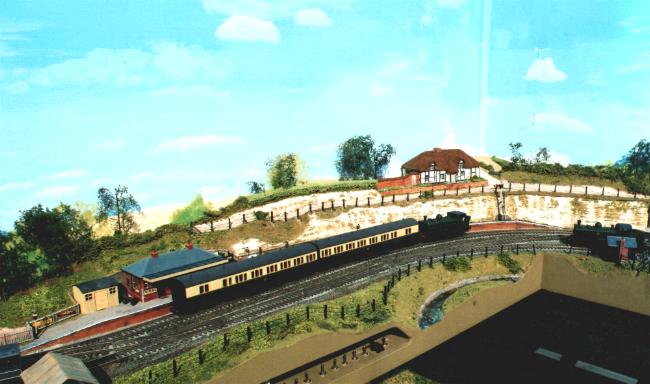 |
"However, late in the morning a through train
from Salisbury arrived.
Not only was it loco-hauled but it had First Class accommodation too!"
indent Another uniquely Great Western
branch line sight was the two coach "B Set". Less commonly known is that
an "A Set" was originally a single composite coach - usually a brake compo -
while a "D Set" was a four-coach set of non-corridor brake third, third, compo
and brake third. (A "C Set" may have existed but I've never seen a photo
of one - unless you know better...) These alpha set descriptions were common only on
"Working Time Tables" where they enabled the make up of trains to be
pre-determined without mentioning specific vehicles.
indent It could be argued that because the B set is a
permanently-coupled pair it is not ideal from the operator's point of view because the
train's make up cannot be changed. While this is true it is not only prototypical
but a B set does make an attractive train aesthetically, even if they were less common
than "scratch sets". Why Hornby or Bachmann do not make more typical
branch/local stock for the Great Western I do not understand - a few
carefully-chosen non-corridor clerestories or some non-clerestory, non-corridor bogie
stock - or even some accurate arc-roofed 4-wheelers - would surely be extremely popular
with any GW modeller because of the added flexibility such stock would give to train
make-up. But I'm having a moan...
indent The original RTR (Ready To Run)
model of this coach was made by Airfix over 20 years ago and has appeared regularly on GWR
model layouts ever since. The currently available model is made by Hornby, as we
have used here.
indent The most notable changes we have made to the standard
model have been to a) paint the bolection mouldings red (these are the "drop light
frames" around the windows in the doors), and b) to remove the standard couplings and
buffers from between the vehicles and replace them with a close-coupling bar made from an
off-cut of plastic card. This semi-permanently couples the vehicles together which
was precisely what was done on the real B sets. Of course we have also c) repainted
the roofs to replace the white lead with a dull, well-weathered grey/brown (it is
wartime!), and d) re-painted the chassis/bogies with a varigated muddy brown reflecting
the "dirt and brakedust" colours you can see if you look at any real coach
chassis today.
| Previous photograph in series | Back to "Upper Isis Room" entrance | Next photograph in series |